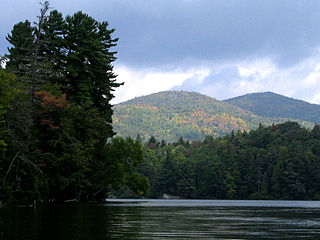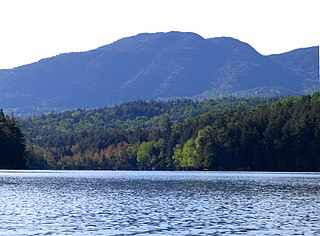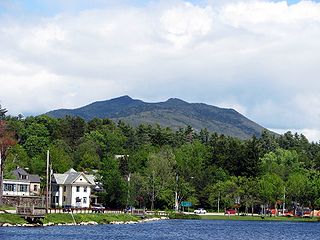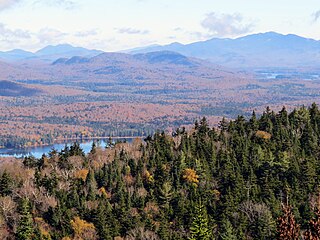

Saint Regis Mountain is a 2,874-foot (876 m) mountain in the town of Santa Clara, New York, in Franklin County at the center of the Saint Regis Canoe Area in the Adirondack Park.

Santa Clara is a town in Franklin County, New York, United States. The population was 345 at the 2010 census. The name was derived from the wife of an early town businessman, John Hurd.

Franklin County is a county in the northern part of the U.S. state of New York. It borders the Canadian provinces of Quebec and Ontario. As of the 2010 census, the county population was 51,599. Its county seat is Malone. The county is named in honor of United States Founding Father Benjamin Franklin.

The Saint Regis Canoe Area in Adirondack Park is the largest wilderness canoe area in the Northeastern United States and the only designated canoe area in New York state. It is closed to motorized vehicles. Among the 58 ponds and lakes are Upper Saint Regis Lake, part of the Seven Carries route, and Saint Regis Pond. It contains the headwaters of the West and Middle Branch of the Saint Regis and the Saranac Rivers. Only two of the lakes can be reached without a portage, or carry as it's known in the region. Primitive canoe camping is permitted on many of the lakes and ponds. Saint Regis Mountain and Long Pond Mountain are within the area.
It can be climbed from a trailhead on Keese Mills Road in Keese Mill, west of Paul Smiths. The trail is a gradual 3.3 mile ascent with a gain of 1168 feet. [1]

Keeses Mills, a.k.a. Keeses Mill and rarely Keese Mill, is a hamlet west of Paul Smiths, New York in the Town of Brighton, Franklin County, New York in the Adirondacks. It is named for a sawmill that was located on the Keeses Mills dam on the Saint Regis River. Keeses Mills road, which starts at Paul Smiths, is the only road in the hamlet; it provides access to Black Pond and Long Pond, trails to Saint Regis and Jenkins Mountains and the Saint Regis Esker Trail, and the middle branch of the Saint Regis River.

Paul Smiths is a hamlet and census-designated place (CDP) in the Town of Brighton in Franklin County, New York, United States. It is located on Lower Saint Regis Lake in the Adirondacks, 12 miles (19 km) northwest of Saranac Lake, located at 44°26' North 74°15' West. The population of the CDP was 671 at the 2010 census.
The view from the summit includes thirty lakes, including the Upper and Lower Saranac Lake, and Upper and Lower Saint Regis Lake. [2] The Adirondack High Peaks can also be seen.

Upper Saranac Lake is one of three connected lakes, part of the Saranac River, in the towns of Santa Clara and Harrietstown, near the village of Saranac Lake in the Adirondacks in northern New York. Upper Saranac Lake is the sixth largest lake in the Adirondacks. With Middle Saranac Lake and Lower Saranac Lake, a 17-mile (27 km) paddle with only one carry is possible. There are 20 primitive campsites accessible by boat available on a first-come basis. Upper Saranac Lake is also known as Sin-ha-lo-nen-ne-pus.

Lower Saranac Lake is one of three connected lakes, part of the Saranac River, near the village of Saranac Lake in the Adirondacks in northern New York. With Middle Saranac Lake and Upper Saranac Lake, a 17-mile (27 km) paddle with only one portage is possible. The Saranac Lake Islands Public Campground provides 87 campsites on inlands in Lower and Middle Saranac Lake. In addition to the Saranac River, it is fed by nearby Lake Colby, Fish Creek, and Lilly Pad Pond. Lower Saranac Lake is located in the town of Harrietstown, New York. The lake, along with both Upper and Middle Saranac Lakes, is also part of the 740-mile Northern Forest Canoe Trail, which begins in Old Forge, NY and ends in Fort Kent, ME.
The Adirondack High Peaks is the name given to 46 mountain peaks in the Adirondack Mountains of New York, United States that were originally believed to comprise all of the Adirondack peaks higher than 4,000 feet (1,219 m). However, later surveying showed that four of the peaks in the group are actually under this elevation, and one additional peak that is close to this elevation had been overlooked. Due to tradition, no mountains were removed from or added to the group as a result of the revised elevation estimates.
The summit is bare rock, having been cleared by a fire started accidentally by a surveying party led by Verplanck Colvin in 1876. The St. Regis Mountain Fire Observation Station is at the summit was restored in 2016 and is now open to the public.

Verplanck Colvin (1847–1920) was a lawyer, author, illustrator and topographical engineer whose understanding and appreciation for the environment of the Adirondack Mountains led to the creation of New York's Forest Preserve and the Adirondack Park.

The St. Regis Mountain Fire Observation Station is a historic fire observation station located on Saint Regis Mountain at Santa Clara in Franklin County, New York. The station and contributing resources include a 35-foot-tall (11 m), steel frame lookout tower erected in 1918, the site of the former observer's cabin, and 9/10 of a mile foot trail between the cabin site and summit. The tower is a prefabricated structure built by the Aermotor Corporation and provided a front line of defense in preserving the Adirondack Forest Preserve from the hazards of forest fires.














